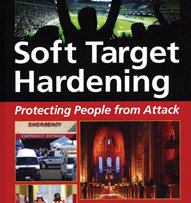Author: Jennifer Hesterman
ISBN No: 9781 4822 44212
Review date: 28/04/2024
No of pages: 321
Publisher: CRC Press
Publisher URL:
http://www.crcpress.com/product/isbn/9781482244212
Year of publication: 13/02/2015
Brief:
Soft Target Hardening: Protecting People from Attack, by Jennifer Hesterman. Published 2014 by CRC Press
The United States, and the world, has had to get used to – with important consequences – suicide terrorism as seen on 9-11. A new book by an American details one further terror tactic that we have had to come to terms with: the attack on the ‘soft target’.
Jennifer Hesterman begins her book Soft Target Hardening with, and returns later to, the September 2013 attack on the Westgate Mall in Nairobi. Shopping malls became a terror target. But as she points out, that’s not novel; the 9-11 hijackers looked into soft targets, whether malls or Disney parks. Russia saw the Beslan school massacre and the Moscow theatre siege; in Mumbai in 2008 terrorists attacked hotels and restaurants. Hesterman notes that much homeland security money and planning has gone on hardening targets that were already hard (embassies and other government buildings, military barracks). Relatively little national security budget has gone (as an American, Hesterman is writing about the US, but it applies to the western world) on civilian venues. “In military terms, we are leaving our flank exposed.”
And as for what that flank is, it’s including churches; schools; and hospitals. From the start, Hesterman does not make a bull-headed demand that civilian buildings harden security – apart from the cost, we want our places of worship, campuses, tourist hotspots and sports stadia to be welcoming. Hence much of the book is given over to threat assessment.
In what has become in a dozen years a highly crowded field of study, homeland security and counter-terrorism, Hesterman has come up with something original and important. It’s a call to action, but not so much about locks and doors – though they do figure – but to make us aware of what she calls ‘a psychological blind eye to soft targeting’. That is, we don’t like to accept that our soft spot – children and teachers, people at a church service, the sick and nurses – are targets. What makes that soft spot more upsetting to admit is that the threat can be an insider – a pupil or a former pupil with a gun, as in some US school and campus massacres. Hesterman ends by raising the balance ‘between normalcy and vigilance’. As she points out, to make changes to soft targets or indeed anywhere for the sake of security against threats may seem as if we are giving in to those threats. “Sadly, the world has changed and so must we.” How we secure vulnerable, because doors-always-open, premises and people is more of a challenge than adding another layer of fortification to the Pentagon or a barracks – as Hesterman knows from experience, having been a military officer on US air force bases – one of the hardest of targets; yet on base are schools, shops and dormitories of families of the service personnel. Hesterman wisely and correctly does not offer certainties or (that dreadful word!) solutions, but measures to lower risk; and above all an attitude, of not feeling helpless against soft target terror.
Soft Target Hardening: Protecting People from Attack, by Jennifer Hesterman. Published 2014 by CRC Press, hardback, 321 pages, £44.99. ISBN 9781 4822 44212. Visit www.crcpress.com.










